I never understood the power of black trim until I moved into my 1940s bungalow three years ago.
The previous owner had painted all the door frames, window casings, and baseboards a crisp black against the white walls, and I initially planned to repaint everything in traditional white.
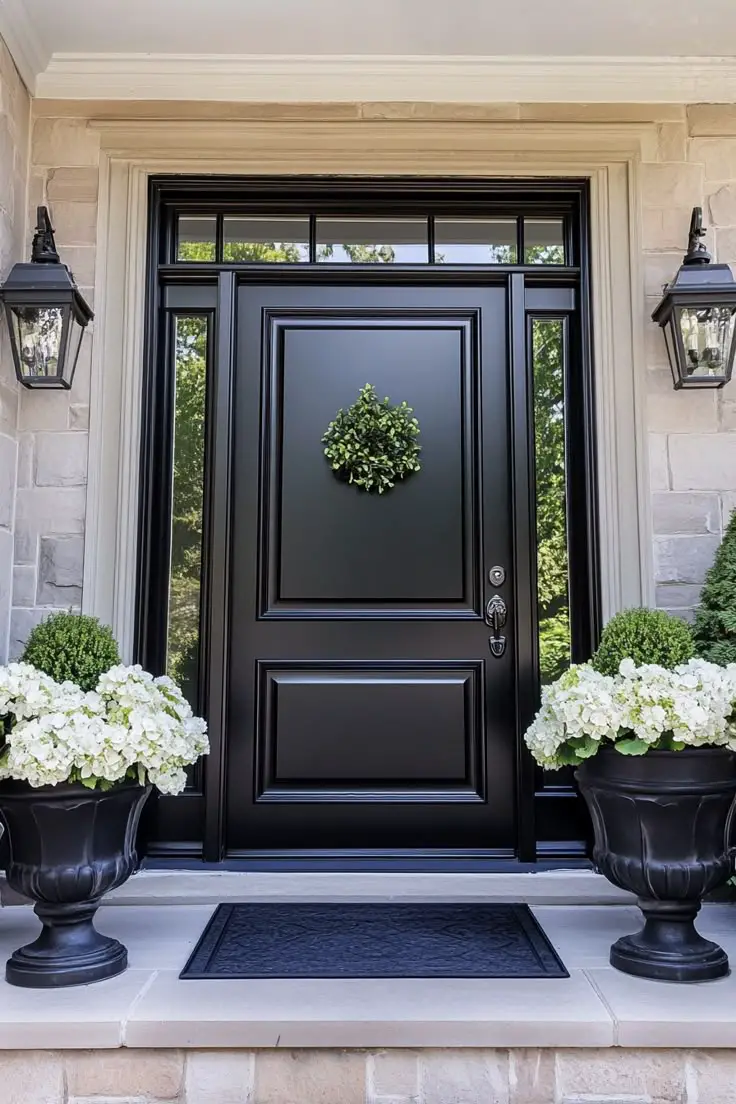
But after living with it for a few weeks, I was completely converted.
The black trim gave the space a defined architectural presence that made even my basic rooms look intentionally designed.
It was like someone had outlined my home with a Sharpie, highlighting all its best features.
Now I’m a total black trim evangelist, finding ways to incorporate this bold design choice into every room renovation.
✨Click to Get My 101 FREE Designer Room Ideas
1. Black Window Frames for Dramatic Views
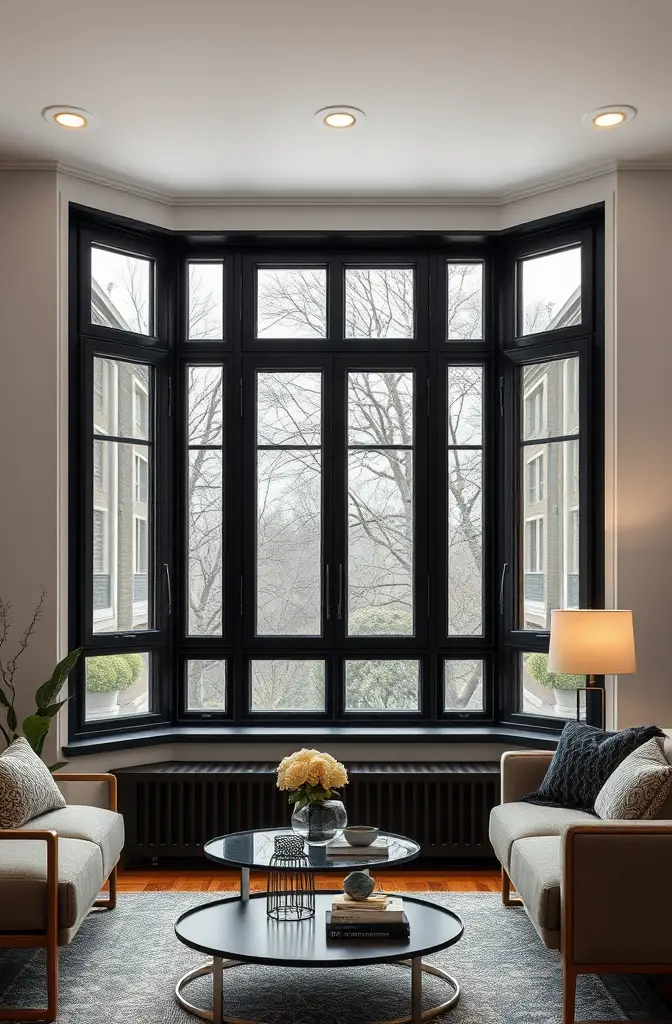

Black window frames create a stunning frame for outdoor views while adding architectural interest to any room.
When you choose black frames instead of traditional white, you’re making your windows a focal point rather than a background element.
The contrast draws your eye immediately to the window, making the view beyond seem more like intentional artwork.
In modern homes, black frames give a sleek industrial edge that pairs beautifully with minimalist décor.
For traditional spaces, black-framed windows add a surprising contemporary touch that prevents the room from feeling too stuffy or dated.
Consider painting existing window frames black as a budget-friendly option that delivers major impact.
If you’re replacing windows, aluminum or steel frames in black offer durability while creating that coveted modern farmhouse or industrial aesthetic.
For a cohesive look, coordinate your window hardware with the same black finish to enhance the overall effect.
The black frames work particularly well when facing greenery or water views, as the stark contrast makes nature’s colors appear even more vibrant.
During evening hours, black window frames virtually disappear, creating the illusion of boundless space beyond the glass.
In smaller rooms, the defined frame can actually make the space feel larger by drawing the eye outward.
When selecting window treatments, simple white or neutral curtains hung high and wide will complement black frames without competing for attention.
Remember that black window frames don’t have to be limited to exterior windows—consider using them for interior glass partitions to create division without sacrificing light flow.
2. Bold Black Door Frames That Make an Entrance

Black door frames transform ordinary doorways into architectural statements that define transitions between spaces.
When you paint interior door frames black, you’re creating a powerful visual portal that guides movement through your home.
The strong outline draws attention to the architectural details of the doorway that might otherwise go unnoticed.
Black door frames work equally well with doors painted in matching black or contrasting white for a striking graphic look.
For added dimension, consider painting both the door frame and the door itself in the same black shade, creating a dramatic entrance to any room.
In open floor plans, black doorframes help delineate spaces without requiring actual walls, adding necessary visual structure.
The vertical lines of black doorframes can also make your ceilings appear higher, especially when the top trim is painted to match.
When selecting a black paint for trim, opt for semi-gloss or satin finishes that will highlight the architectural details while being easier to clean than matte options.
For historic homes, highlighting original doorway details with black paint can emphasize craftsmanship that spans generations.
Contemporary spaces benefit from the crisp definition that black doorframes provide, adding necessary visual weight to minimal designs.
Consider carrying the black trim treatment to nearby elements like chair rails or picture rails for a cohesive, deliberate design statement.
The strong contrast between black frames and lighter walls creates natural focal points that can guide your furniture arrangement.
Remember that black doorframes don’t require black doors—you can mix and match for varied effects throughout your home.
3. Striking Black Baseboards for Modern Edge
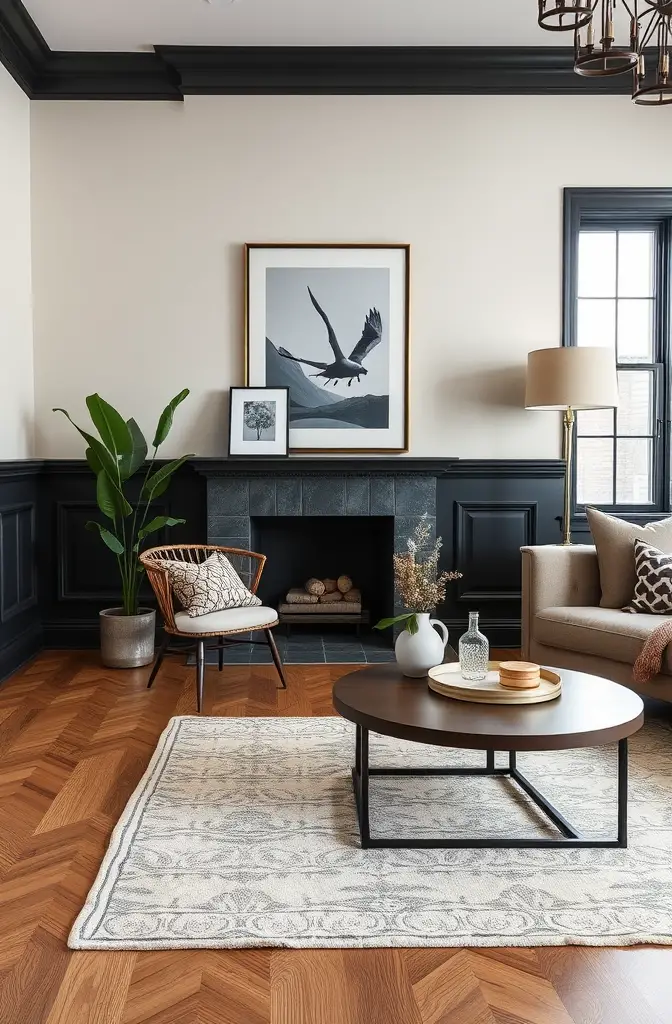
Black baseboards offer a surprising twist on traditional white trim that grounds rooms with sophisticated edge.
When you switch from standard white to black baseboards, you’re adding a strong horizontal line that anchors your walls to the floor.
The effect is particularly striking with light walls, creating a clear boundary that adds architectural significance.
Black baseboards work wonderfully in minimalist spaces where they add necessary visual weight and prevent rooms from feeling too stark or sterile.
In traditional homes, black baseboards offer an unexpected contemporary element that keeps classic designs from feeling outdated.
The horizontal black line created by baseboards can visually widen a room, making it appear more spacious than it actually is.
For a cohesive look, consider carrying the black baseboard treatment throughout multiple rooms or even the entire home.
The contrast between dark baseboards and light walls emphasizes the proportions of your space in a way that all-white trim simply cannot achieve.
When paired with hardwood floors, black baseboards create a beautiful transition that frames your flooring while adding depth to the room.
For rooms with black or dark furniture, matching baseboards create visual continuity that ties the design together seamlessly.
Consider using black quarter-round molding at the junction between baseboards and flooring for a complete, finished look.
In homes with pets or children, black baseboards have the practical advantage of hiding scuffs and marks better than their white counterparts.
The modern edge provided by black baseboards can be softened with traditional furniture, creating an interesting juxtaposition of styles.
Remember that paint isn’t your only option—black tile baseboards in bathrooms or black wooden baseboards in main living areas can add textural interest.
4. Sophisticated Black Crown Molding for Ceiling Definition
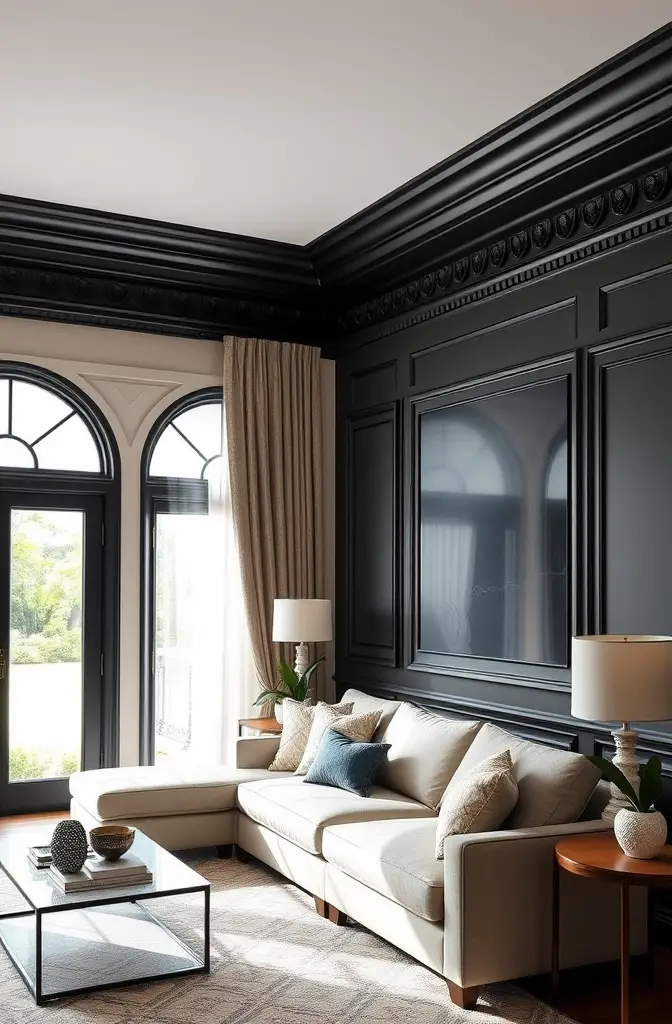
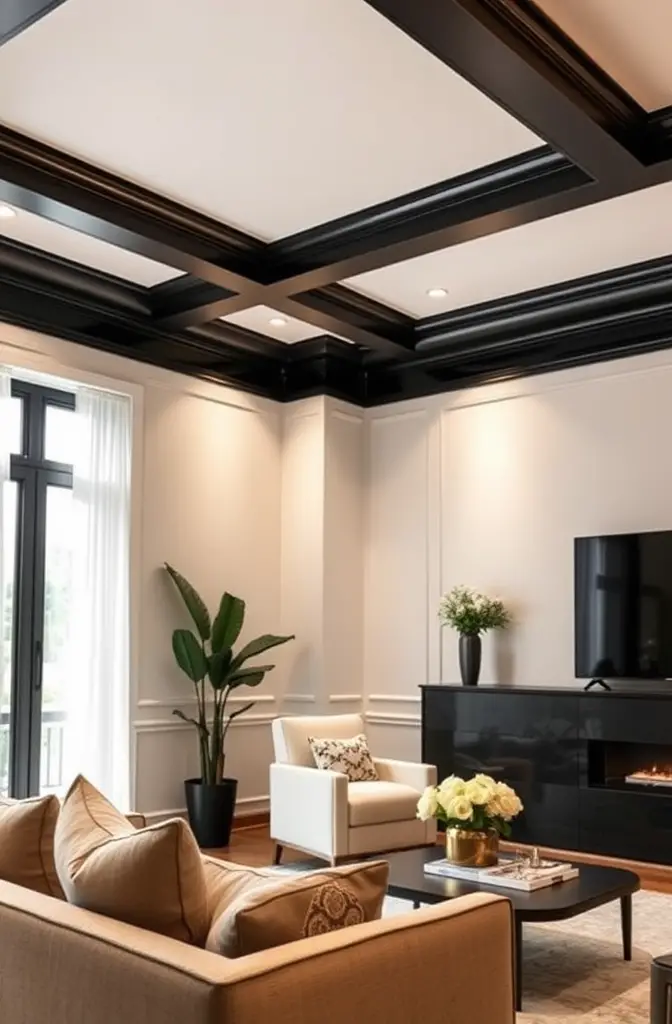
Black crown molding creates a spectacular frame around your ceiling that adds instant architectural gravitas to any room.
When you opt for black crown molding rather than traditional white, you’re creating a striking silhouette that draws the eye upward.
This unexpected choice highlights the transition between wall and ceiling, treating this junction as a design feature rather than an afterthought.
In rooms with high ceilings, black crown molding can actually make the space feel more intimate and proportional by visually lowering the ceiling line.
For rooms with detailed, ornate moldings, black paint highlights the craftsmanship and shadows within the design that might be lost in white.
The dramatic outline created by black crown molding works particularly well in dining rooms, creating a formal, elegant atmosphere.
Consider pairing black crown molding with a ceiling painted in a contrasting color or pattern for a truly custom, high-end look.
In modern homes, even simple black crown molding adds architectural interest that prevents spaces from feeling too sterile or unfinished.
For a bold statement, coordinate your black crown molding with black window frames or door casings to create a cohesive framework throughout the room.
The clean line created by black crown molding can help define multi-functional spaces within open floor plans.
In rooms with wallpaper, black crown molding frames the pattern beautifully, containing the design in a purposeful way.
Remember that crown molding doesn’t have to be elaborate—even a simple black picture rail or thin crown molding makes a contemporary statement.
For an ultra-dramatic look, consider extending the black trim to ceiling beams or coffered ceiling details for a complete architectural transformation.
The contrast between dark crown molding and a light ceiling highlights the dimensions of your room, making it feel more deliberately designed.
✨Click to Get My 101 FREE Designer Room Ideas
5. Black Picture Rails for Gallery-Worthy Walls
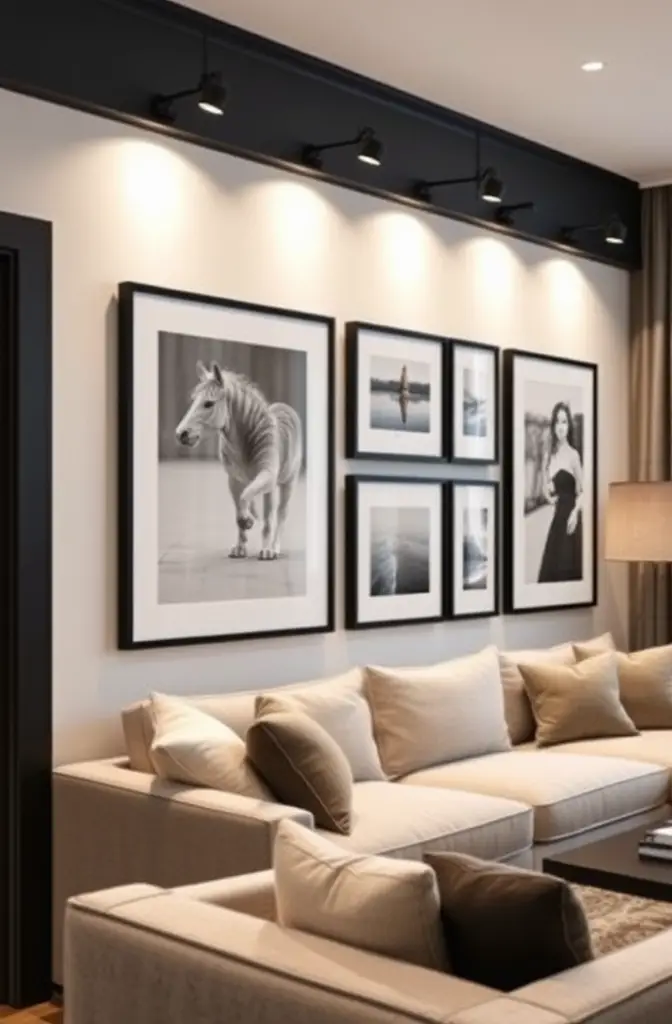
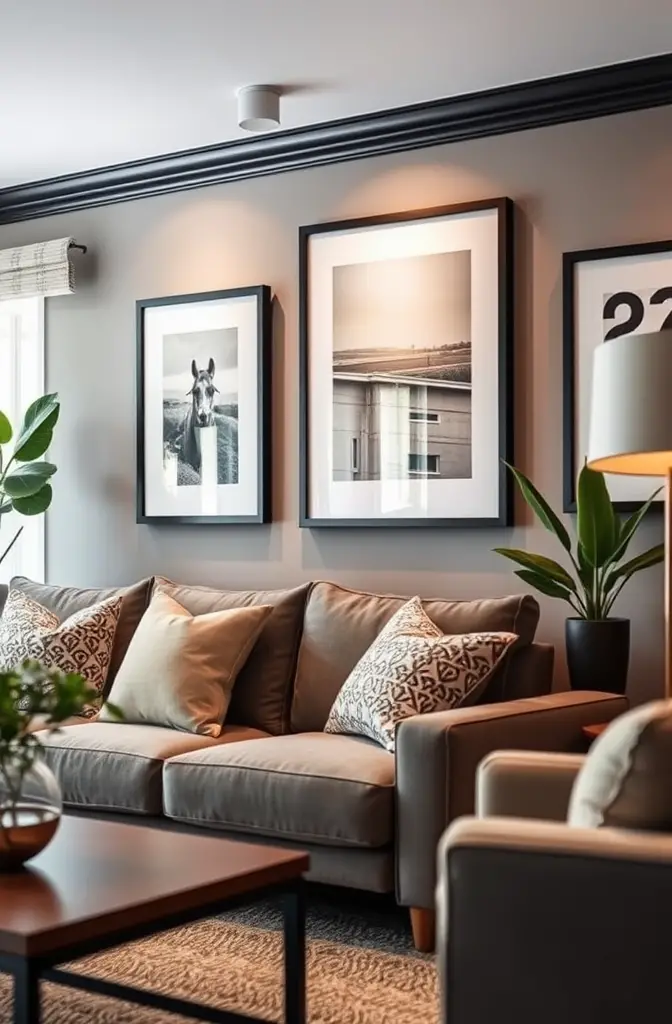
Black picture rails create a distinctive horizontal line that adds architectural interest while providing practical functionality for art displays.
When you install a black picture rail in your home, you’re tapping into a classic architectural detail with both aesthetic and functional benefits.
The strong horizontal line created by the rail visually divides your wall, creating proportion and scale even in basic rectangular rooms.
Traditional picture rails were installed about 18-24 inches from the ceiling, but you can adjust this height to suit your ceiling height and proportions.
The black finish makes the rail stand out as an intentional design element rather than a purely functional addition.
With a properly installed picture rail, you can hang and rearrange artwork without putting additional holes in your walls.
Consider painting the wall area above the picture rail in a different color or shade to emphasize the architectural division.
For a cohesive look, coordinate your black picture rail with other black trim elements like window frames or baseboards.
In rooms with tall ceilings, a black picture rail visually lowers the perceived ceiling height, creating a more intimate, human-scaled space.
The hardware used to hang art from your picture rail can become a design element itself—consider decorative hooks or even colored cords for added interest.
Black picture rails work particularly well in hallways, transforming otherwise utilitarian passages into gallery-like spaces for displaying art.
For rentals, a black picture rail offers a solution for hanging art without damaging walls, while still adding architectural character.
In minimalist spaces, the strong horizontal line of a black picture rail adds necessary visual structure and weight to sparse designs.
Remember that picture rails don’t have to support only pictures—they can display lightweight sculptures, plants, or other decorative elements on specially designed hooks.
6. Dramatic Black Built-ins That Showcase Collections

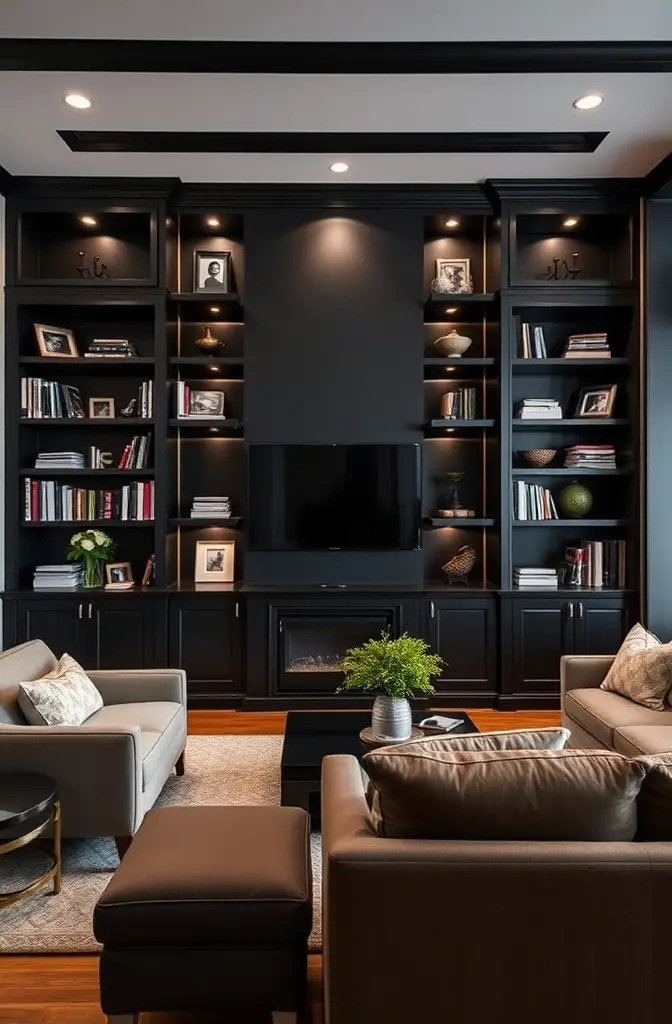
Black built-in shelving and cabinetry creates sophisticated display space that makes your belongings look like museum-worthy collections.
When you opt for black built-ins instead of traditional white or wood tones, you’re creating a dramatic backdrop that makes colorful objects pop.
The dark background recedes visually, allowing your books, art, and decorative objects to stand out as the stars of the show.
Black built-ins instantly add architectural weight to any room, creating a focal point that anchors the entire space.
In libraries or home offices, black bookshelves lend a sense of sophistication and gravitas that elevates the entire room.
Consider contrasting the black exterior with a different interior color—vibrant jewel tones or even white can create striking depth.
The clean lines of black cabinetry create a gallery-like setting that elevates even everyday objects to display-worthy status.
For media walls, black built-ins allow televisions to blend in rather than dominate the visual composition of the room.
Open shelving in black creates a strong framework for displaying collections while maintaining a sense of lightness that full cabinetry might lack.
If complete black built-ins feel too overwhelming, consider black trim elements around white or wood cabinets for a more subtle approach.
Built-in lighting becomes even more impactful against black backgrounds, creating dramatic spotlighting effects for prized possessions.
In kitchen and dining areas, black glass-front cabinets showcase special dishware or glassware collections with sophisticated elegance.
Remember that black built-ins don’t have to fill an entire wall—even a small black built-in niche can create a powerful focal point.
The contrast between black cabinetry and light walls creates defined architectural presence that makes even newer homes feel established and intentional.
7. Black Interior Door Panels for Architectural Depth
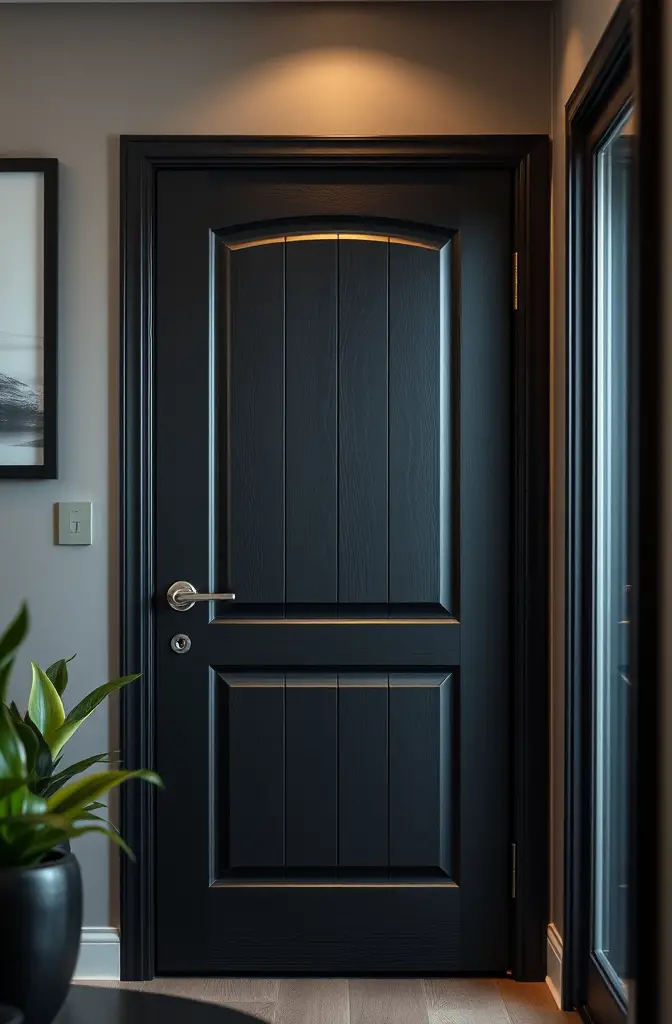
Black interior doors add immediate architectural significance to every room transition in your home.
When you paint interior doors black while keeping trim white (or vice versa), you’re creating striking contrast that demands attention.
The dark panels transform standard doors into statement pieces that add depth and character to otherwise basic interiors.
In hallways with multiple doors, black door panels create rhythm and repetition that transforms the space into an intentional design element.
Consider keeping the door frame white while painting the inset panels black for a sophisticated, tailored look with strong dimensional presence.
For paneled doors, black paint highlights the architectural details and shadow lines that might be lost with all-white treatments.
Black doors work particularly well as transitions to private spaces like bedrooms or offices, signaling a change in function and atmosphere.
In period homes, black doors honor historical precedent while adding contemporary flair to traditional architecture.
The stark contrast of black doors against light walls creates natural focal points that can guide furniture placement and traffic flow.
If full black doors feel too dramatic, consider black door hardware against white doors as a more subtle nod to this trend.
For a truly custom look, add picture frame molding to flat doors before painting them black—this inexpensive upgrade creates instant architectural detail.
Remember that black doesn’t have to mean solid black—consider black glass inserts or black metal and glass doors for areas where light flow matters.
In modern homes, simple slab doors painted black create clean geometric statements that complement contemporary architecture.
The versatility of black doors means they pair beautifully with virtually any interior style, from farmhouse to mid-century modern.
8. Black Ceiling Beams for Dramatic Overhead Interest
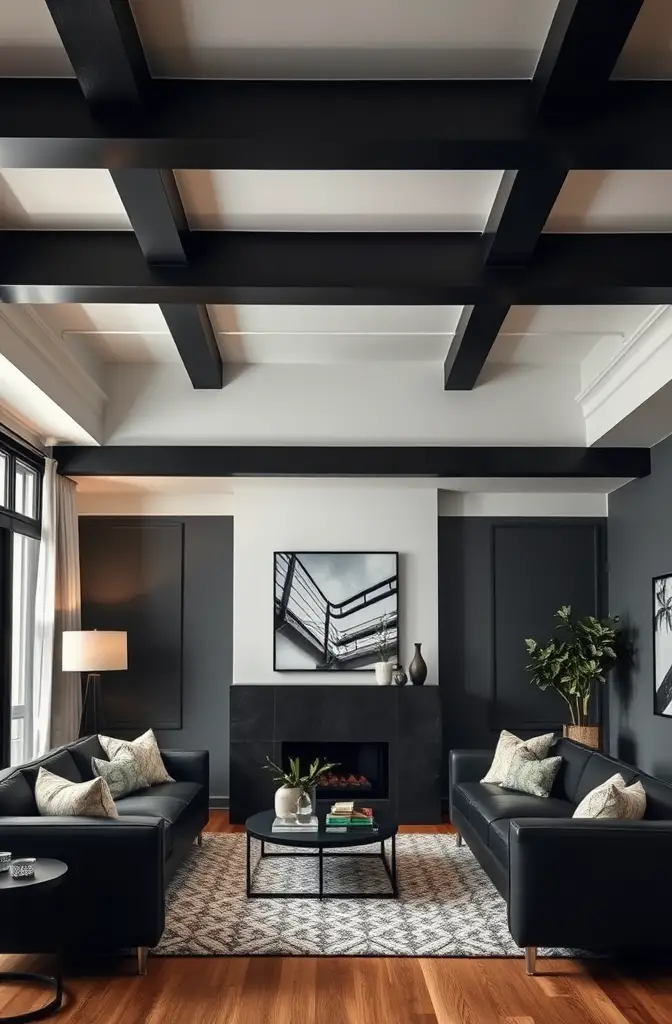
Black ceiling beams transform ordinary ceilings into architectural showstoppers that draw the eye upward with dramatic effect.
When you paint existing beams black or install new black beams, you’re adding strong geometric lines that create rhythm and structure overhead.
The contrast between dark beams and a light ceiling creates depth and dimension that flat, white ceilings simply cannot achieve.
In rooms with high ceilings, black beams can actually make the space feel more intimate by bringing visual weight downward into the room.
Consider combining black beams with other black trim elements like window frames for a cohesive, intentionally designed aesthetic.
For homes without structural beams, decorative false beams in black can add instant architectural character to basic box rooms.
The strong directional lines of black beams naturally lead the eye across the ceiling, making rooms appear larger or guiding movement through a space.
In great rooms or open floor plans, black ceiling beams help define separate functional areas without requiring walls or partitions.
Consider crossing patterns like coffered ceilings painted black for maximum architectural impact in formal spaces like dining rooms.
For a contemporary twist on traditional beamed ceilings, install simple black metal beams rather than bulky wood versions.
Black ceiling beams work particularly well in spaces with industrial or farmhouse design elements, reinforcing those stylistic choices.
Remember that beams don’t have to cover the entire ceiling—even a few strategic black beams can create architectural interest where needed.
The shadows cast by black beams add additional visual texture throughout the day as natural light changes.
In contemporary homes, clean-lined black beams create necessary contrast and visual weight that prevents minimalist spaces from feeling sterile.
✨Click to Get My 101 FREE Designer Room Ideas
9. Black Stair Elements for Dramatic Vertical Impact
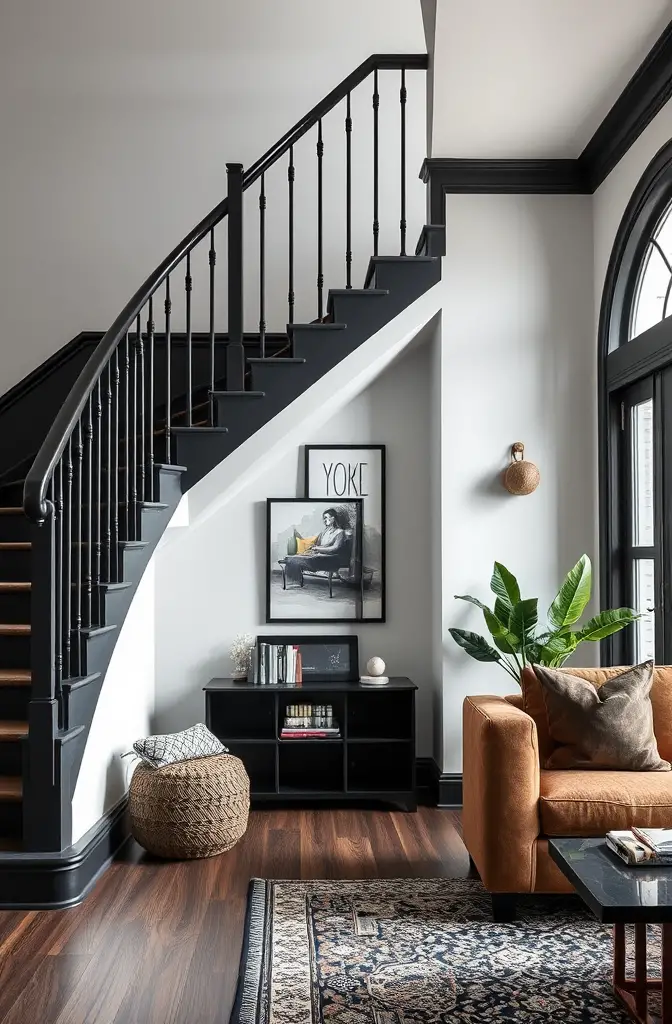

Black stair components create powerful vertical lines that draw the eye upward while adding sophisticated architectural detail.
When you incorporate black elements into your staircase, you’re highlighting one of the most important transitional features in your home.
Consider painting just the stair risers black while keeping treads natural wood for a striking striped effect that emphasizes the ascent.
Black balusters against white railings create graphic rhythm that transforms a utilitarian element into an artistic focal point.
For a bold approach, paint the entire staircase black for a sculptural statement that anchors open floor plans with dramatic presence.
The contrast between black stair elements and light walls creates depth that highlights the architectural lines of this essential structure.
Consider keeping the stair structure white while adding a black runner for a more traditional approach with contemporary contrast.
Black metal balusters offer a sleek alternative to wood, creating an industrial-inspired look that works well in modern interiors.
For a subtle approach, paint just the handrail black while keeping other elements white or wood-toned for a tailored, refined look.
In homes with open staircases, black components frame the negative space beneath, turning it into an intentional design feature.
The vertical lines of black balusters can make ceiling heights appear taller, enhancing the sense of space in your entryway or hall.
Consider painting the stringers (the diagonal supports on the sides of the staircase) black for a strong outline that frames the entire structure.
For traditional homes, black paint highlights the craftsmanship and detailing of newel posts and turned balusters that might be lost in all-white treatments.
Remember that stair renovations don’t have to be all-or-nothing—even painting a single element black can dramatically transform your staircase’s appearance.
10. Black Wall Paneling for Textural Sophistication
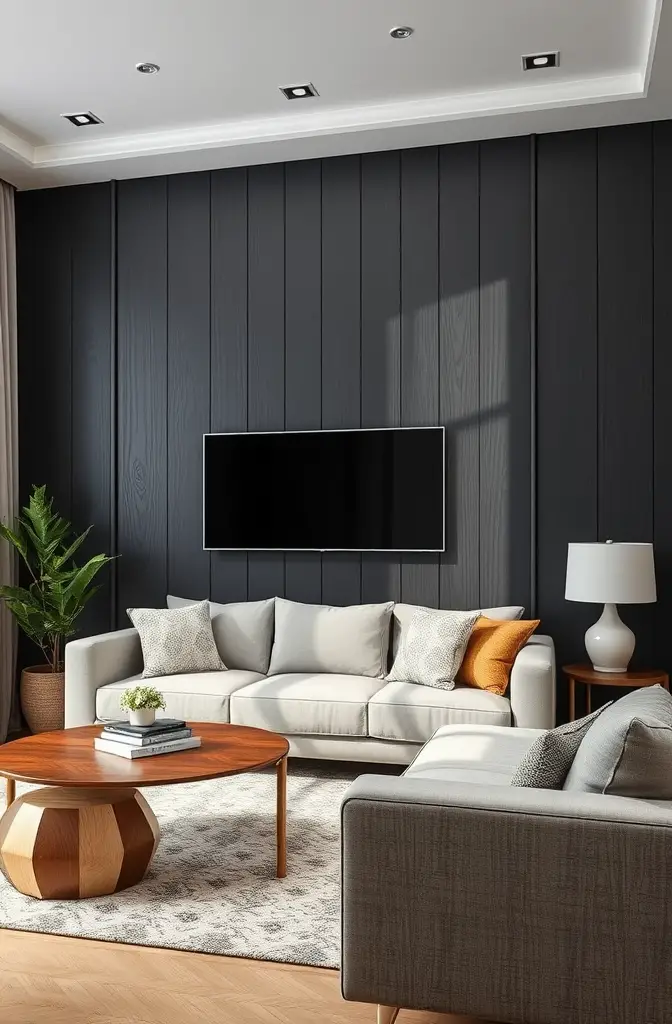
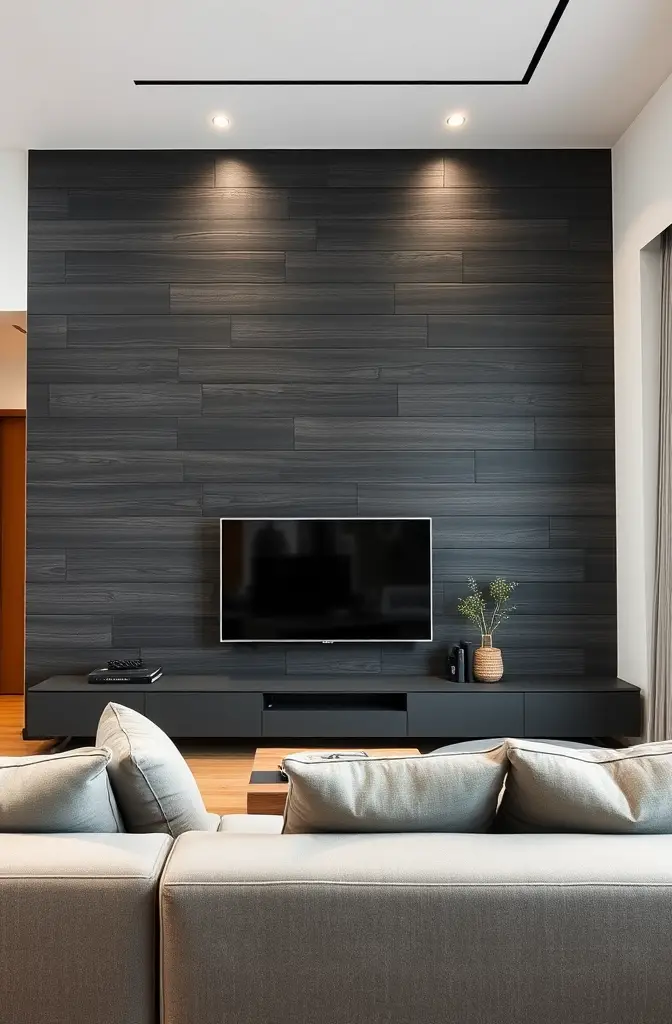
Black wall paneling creates textured dimension that elevates simple walls into architectural features with depth and character.
When you install black wainscoting, shiplap, or board-and-batten, you’re adding both color contrast and textural interest in one bold move.
The combination of shadows and highlights created by paneling details becomes even more pronounced when painted in dark colors.
Consider installing black paneling on just a portion of your wall—half-height wainscoting or a chair rail with paneling below creates balanced contrast.
In dining rooms, black paneling creates a formal, intimate atmosphere that enhances special gatherings and dinner parties.
For modern spaces, simple vertical black paneling adds necessary architectural interest without feeling too traditional or fussy.
The strong vertical lines in black panel molding can make ceiling heights appear taller, enhancing the sense of space in your room.
Consider combining black paneling with complementary wallpaper above for a bold design statement that adds both color and texture.
Black shiplap offers a contemporary twist on a farmhouse classic, adding horizontal linear texture that can visually widen a narrow room.
In bathrooms, black beadboard or vertical paneling adds waterproof protection while creating sophisticated spa-like ambiance.
For a dramatic foyer, black panel molding creates a memorable first impression that sets the tone for your entire home’s design approach.
Remember that black paneling doesn’t have to cover entire walls—even small sections of black-painted texture can create powerful focal points.
The deep shadows created by black panel details add visual depth that flat painted walls simply cannot achieve.
In traditional homes, black paneling honors historical precedent while adding contemporary drama to classic architectural elements.
11. Bold Black Fireplace Surrounds for Focal Point Drama
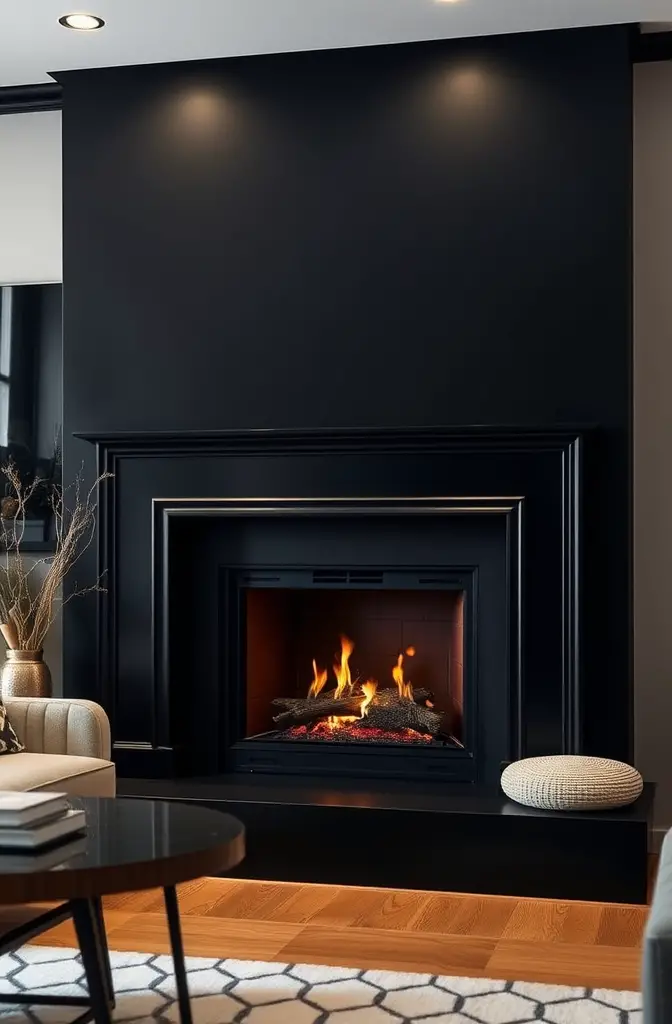
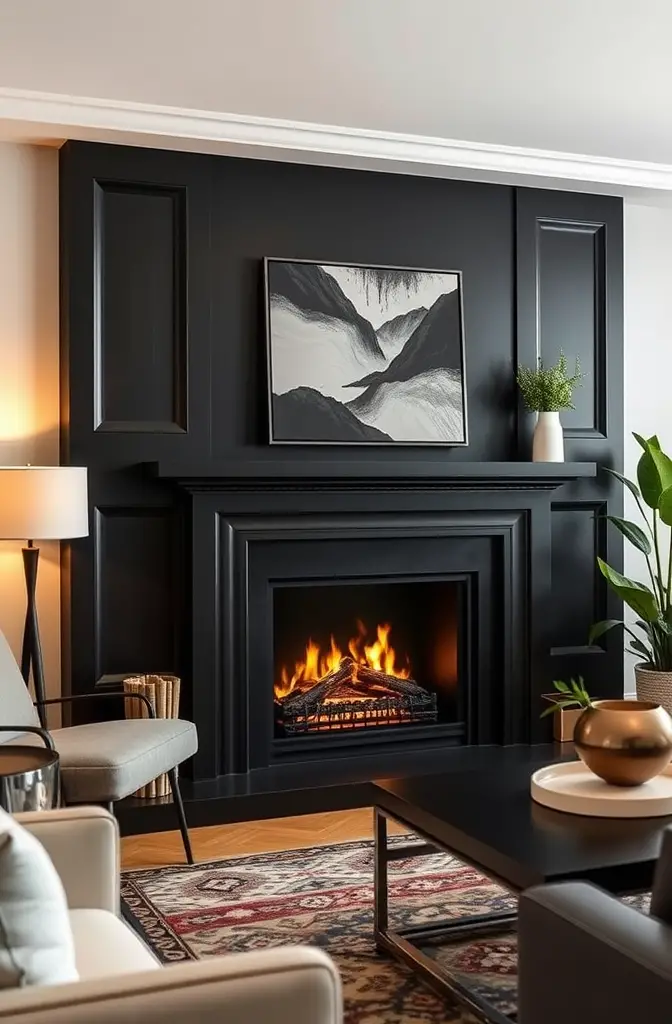
Black fireplace surrounds transform this natural focal point into a dramatic anchor that grounds your entire room design.
When you paint your fireplace surround black, you’re emphasizing its importance as the heart of the room with bold definition.
Consider contrasting a black mantel against a light brick or stone fireplace for a striking two-tone effect that highlights architectural lines.
For a more dramatic approach, paint the entire fireplace wall black, treating it as an accent wall that showcases this important feature.
The strong silhouette created by a black fireplace surround frames the fire itself, making flames appear even more vibrant against the dark background.
In rooms without working fireplaces, black paint highlights the architectural feature of the fireplace even when it’s not in use.
Consider extending the black treatment to built-in bookshelves or cabinetry flanking the fireplace for a cohesive statement wall.
For modern homes, a simple black slab surround creates clean lines that complement contemporary furnishings and architecture.
The contrast between a black fireplace and light walls creates natural focal points that can guide furniture arrangement and room layout.
Traditional carved mantels take on new life when painted black, highlighting details and craftsmanship that might be lost in all-white treatments.
For industrial spaces, black metal fireplace surrounds add appropriate edge while emphasizing the fireplace as a central gathering spot.
Remember that you don’t have to commit to solid black—consider black marble, slate, or tile for textural interest with the same dramatic effect.
In minimalist spaces, a black fireplace surround adds necessary visual weight that prevents the room from feeling too stark or sterile.
The versatility of black fireplaces means they complement virtually any interior style, from traditional to ultra-modern, making them a timeless choice.
12. Black Kitchen Cabinet Frames for Chef-Worthy Style
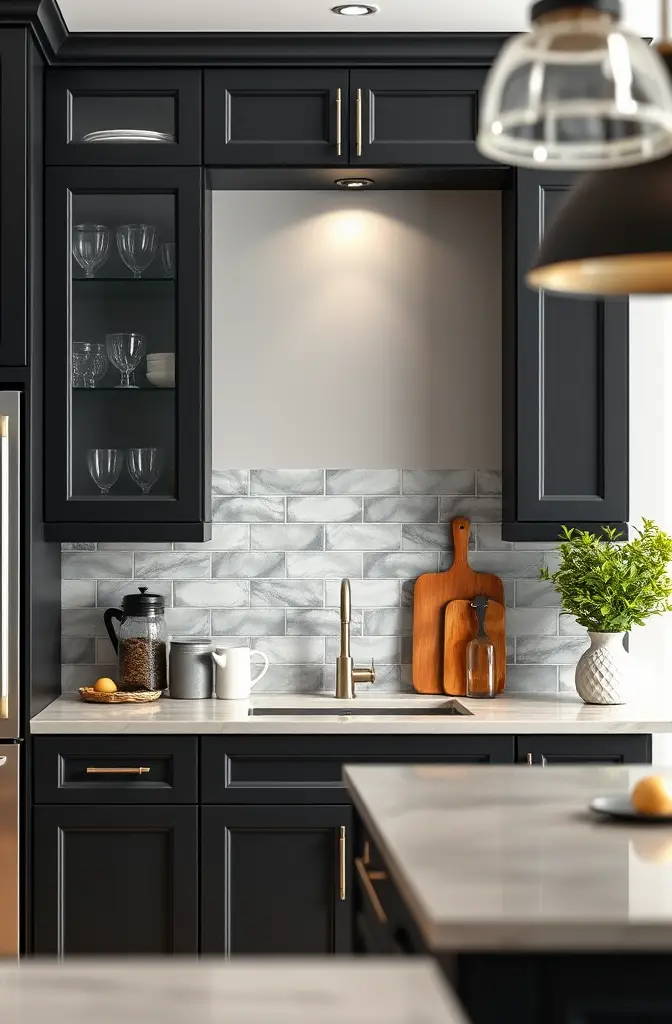
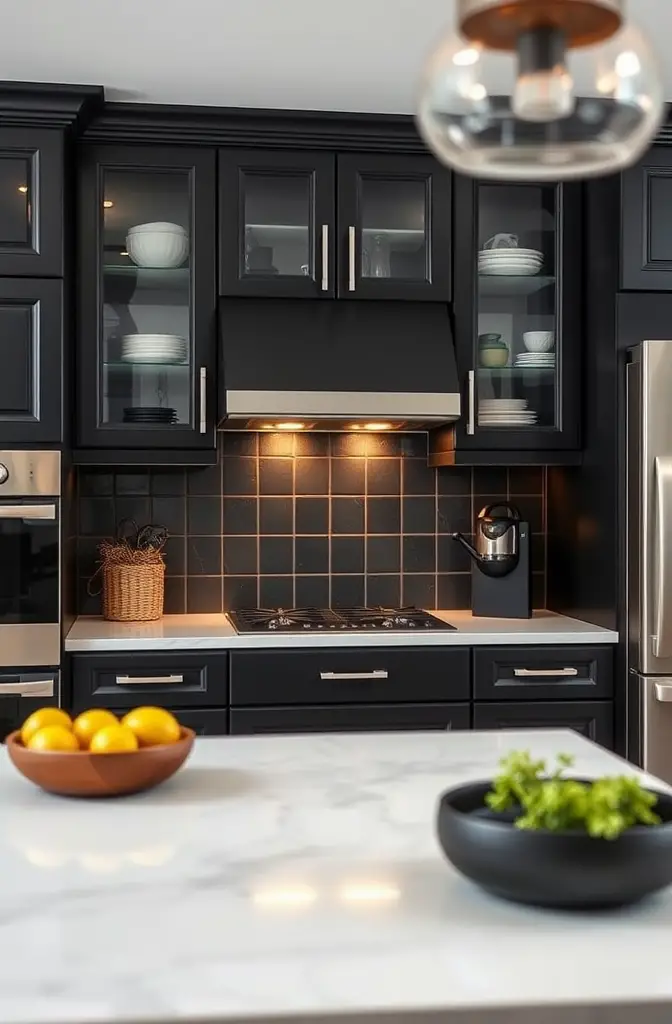
Black kitchen cabinet frames paired with contrasting door fronts create sophisticated culinary spaces with custom, high-end appeal.
When you choose black cabinet frames with white, wood, or glass door fronts, you’re creating a layered look that adds architectural depth to your kitchen.
The strong outline formed by black frames highlights the geometry of your cabinet layout, turning standard cabinetry into a design feature.
Consider black frames around glass cabinet doors for a display-worthy showcase that makes everyday dishes look like curated collections.
For a tuxedo kitchen effect, use black cabinet frames on upper cabinetry with all-black lower cabinets for grounded sophistication.
The contrast between black frames and lighter door fronts creates visual interest without the heaviness of all-black cabinetry.
Black cabinet frames pair beautifully with both light and dark countertops, offering versatile design options for any kitchen style.
Consider carrying the black frame treatment to kitchen islands or pantry doors for a cohesive, intentionally designed culinary space.
The clean lines of black frames naturally complement other black elements like faucets, lighting, or appliances for a coordinated aesthetic.
For a personalized approach, combine black frames with multiple door front materials—perhaps glass for display cabinets and painted fronts for others.
Black cabinet frames work particularly well in kitchens with architectural character, reinforcing craftsmanship and attention to detail.
In open concept homes, black-framed kitchen cabinetry helps define the kitchen zone while adding visual weight to the open layout.
Remember that black cabinet frames can be achieved through paint on existing cabinetry or through new construction with contrasting materials.
The sophisticated edge provided by black cabinet framing elevates standard kitchens into custom-looking culinary spaces with designer appeal.
✨Click to Get My 101 FREE Designer Room Ideas
13. Black Bathroom Fixtures for Spa-Like Contrast
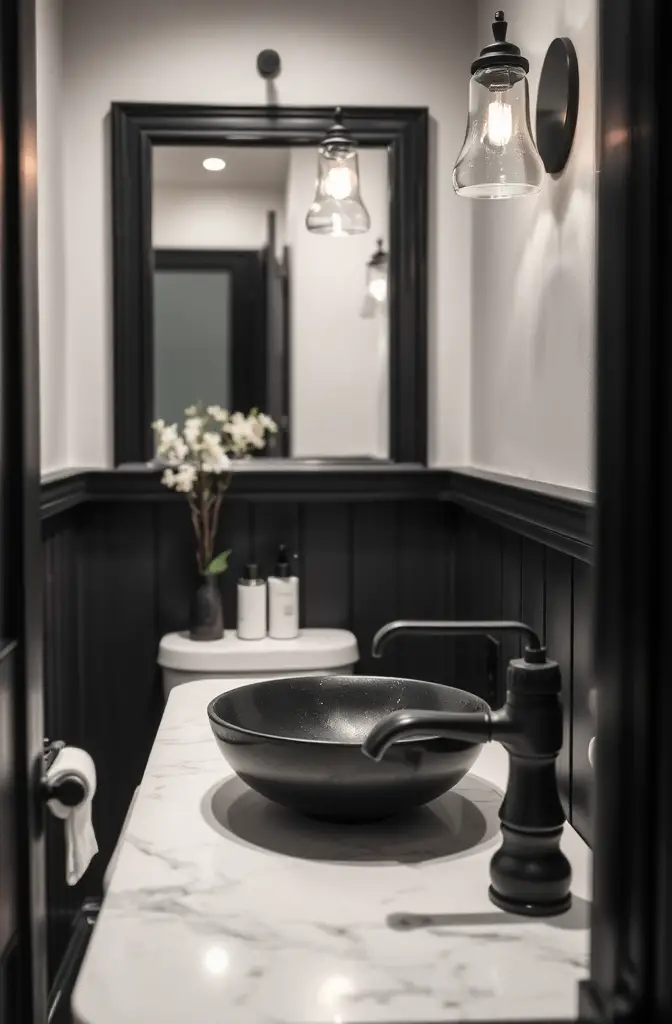
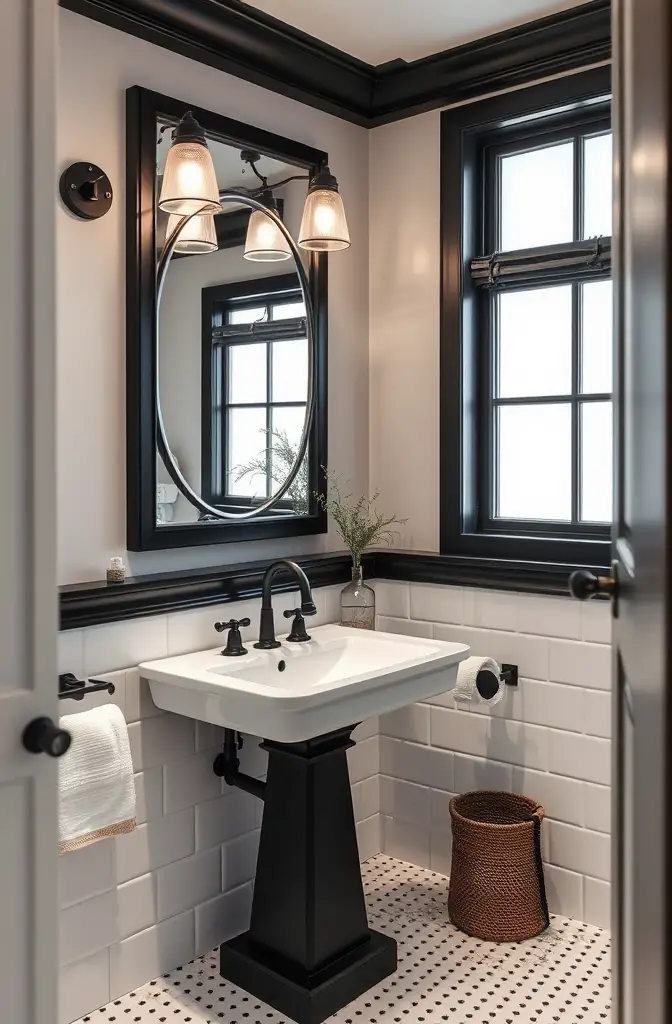
Black bathroom fixtures create dramatic contrast against light surfaces, transforming utilitarian spaces into sophisticated retreats.
When you choose black faucets, shower fixtures, and hardware, you’re adding graphic punctuation that draws attention to the function and form of these essential elements.
The matte black finish popular in contemporary fixtures absorbs light rather than reflecting it, creating depth and sophisticated presence.
Consider black framed shower doors against white tile for a stunning graphic statement that elevates standard bathroom enclosures.
For a coordinated look, extend the black accent to towel bars, toilet paper holders, and other hardware throughout the space.
The sharp contrast between black fixtures and white porcelain creates focal points that add interest to otherwise basic bathroom features.
Black shower fixtures against light tile create a spa-like atmosphere that feels both clean and dramatically sophisticated.
Consider black-framed mirrors to enhance the graphic impact and tie together your bathroom’s black accent elements.
For a balanced look, incorporate black elements into lighting fixtures to carry the theme upward and create visual continuity.
Black plumbing fixtures work particularly well with natural stone elements like marble, creating elegant contrast that highlights the stone’s organic patterns.
In small bathrooms, black accents add necessary visual interest without requiring extensive renovation or expansive square footage.
Remember that black fixtures don’t mean committing to an entirely black bathroom—even selective black elements against an otherwise light space create powerful impact.
The versatility of black bathroom fixtures means they complement virtually any style, from traditional to ultra-modern, making them a timeless choice.
For a particularly striking look, pair black fixtures with brass or gold accents for a luxurious mixed-metal approach with depth and character.

